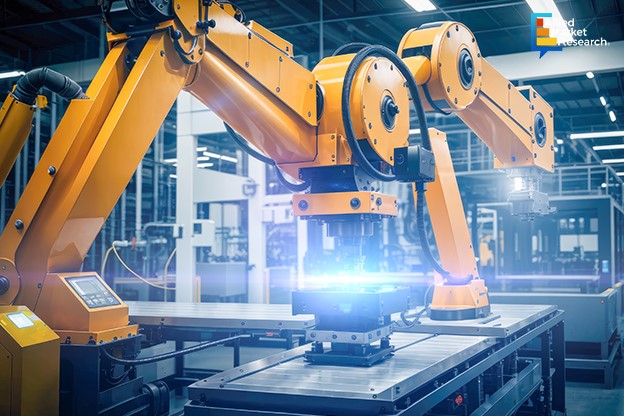How Can AI in Laser Welding Systems Propel Your Business with Optimum Accuracy?

19 Jan
2024
Highlights:
- How can the integration of AI in laser welding systems amplify your business?
- What are the latest types of laser welding systems improving accuracy across industries?
- Light on the global expansion of the laser welding system sector
Laser welding is a cutting-edge technique that plays an important role in modern manufacturing. It is vital for industries such as aerospace and medical device manufacturing that demand exceptional precision and accuracy in their welding processes. This article talks about how the integration of AI in laser welding systems can reshape the industry with new possibilities and how the latest types of these systems are benefiting industries.
How can artificial intelligence in laser welding systems help detect good and bad welds?
The integration of artificial intelligence with laser welding systems has opened a wide range of applications across various industries, especially medical device manufacturing. Such machines are effective for welding stainless steel aerospace components and well-suited for various welding applications in medical device manufacturing such as designing surgical instruments, medical equipment, and tubing. Furthermore, AI can enhance the capabilities of laser welding systems with off-axis vision. The systems use AI-powered cameras and software to detect welding errors with lightning speed and accuracy. The cameras can upgrade the power of the RTX graphics card to identify unevenness and defects in the weld. This cutting-edge technology has revolutionized the aerospace sector by detecting slight defects in the welding quality of aerospace components. With rapid technological developments, AI can also find its applications in the laser material processing sector.
What are the latest types of laser welding systems benefiting industries?
Nowadays, gas laser welding systems and fiber laser welding systems have become popular among industries. Gas laser welding systems use gases such as helium, argon, and nitrogen to create a stable and clean welding environment and prevent the welds from oxidation and contamination. For instance, helium is used to weld aluminum and other non-ferrous metals to remove extra heat from the welding area quickly. Similarly, argon is used to weld stainless steel and other alloys to avoid their reaction with other metals at high temperatures. These advanced systems can find applications in jewelry manufacturing, automotive manufacturing, telecommunications, and more. On the contrary, fiber laser welding systems use a laser beam as the heat source. Such systems require less maintenance and offer fast welding speeds. They offer applications in manufacturing body panels and exhaust systems for vehicles, for lightweight material joining in aerospace engineering, and other intricate welding applications across industries.
Competitive landscape of the laser welding system domain: Some profitable mergers and acquisitions
The global laser welding industry has experienced striking growth, driven by the increasing trends of automation across industries for greater accuracy and improved productivity. The sector is examined across several countries. Based on this analysis, India is expected to showcase the highest CAGR of 8.0% during 2023-2032. Moreover, the domain has also undergone several mergers and acquisitions to foster the competitive landscape. For instance, Advance Welding, a leading UK-based manufacturer of innovative electrofusion welding equipment announced its acquisition of KTI, Inc., to serve existing customers in various fields such as aerospace & military, electronics, energy utility, and medical with advanced electron beam welding and laser beam welding systems.
Another instance is the acquisition of Oregon Laser Welding Equipment Company by Dukane, a leading provider of laser plastic welders. With this acquisition, Dukane aimed to expand its product portfolio by using the Blackhawk technology of Oregon Group and offer a wide range of applications in the electronics, automotive, and medical sectors.
To conclude, the rising demand for material processing across several industries including industrial machinery, electronics, and medical will boost the sector with immense growth opportunities. Moreover, the increasing development of eco-friendly and energy-efficient lasers can drive the sector to reach extensive goals.
To gain informed investment opportunities in the dynamic landscape of the laser welding system industry, talk to our experts today!

Rosy Behera
Author's Bio- Rosy Behera holds a bachelor’s degree in Electrical and Electronics Engineering and now she is a content writer by profession. She loves to portray her thoughts and ideas with a nice command of words. Grabbing an audience with her creative write-ups is one of her biggest assets so far. Apart from writing, she is a certified “Odisi” dancer and has done Gardharva in Drawing, Painting, and Arts. She always explores new things through travel and is a big foodie.
Avenue: Entire Library membership of Allied Market Research Reports at your disposal
- Avenue is an innovative subscription-based online report database.
- Avail an online access to the entire library of syndicated reports on more than 2,000 niche industries and company profiles on more than 12,000 firms across 11 domains.
- A cost-effective model tailored for entrepreneurs, investors, and students & researchers at universities.
- Request customizations, suggest new reports, and avail analyst support as per your requirements.
- Get an access to the library of reports at any time from any device and anywhere.
Related Post
-
How are Submarine Cables Transforming Global Connectivity with Enhanced User Experience?
-
Endoscopy Procedures: Transformations in Techniques and Applications
-
AI-Powered Video Analytics: How the Product Actually Works for enterprises
-
Painting Robots: Transforming Precision Coating and Creative Applications
-
Innovations in Pharmacovigilance Systems Advancing Patient Safety
-
Understanding Edge Security: Keeping Data Safe Near the Source
-
Exploring the Use and Advancements of 3D Laser Scanners in Professional Applications
-
Reinforcing Industrial Controls with Smarter Tools and Training








